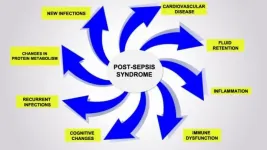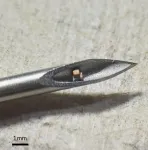(Press-News.org) An article published in Frontiers in Immunology suggests that sepsis can cause alterations in the functioning of defense cells that persist even after the patient is discharged from hospital. This cellular reprogramming creates a disorder the authors call post-sepsis syndrome, whose symptoms include frequent reinfections, cardiovascular alterations, cognitive disabilities, declining physical functions, and poor quality of life. The phenomenon explains why so many patients who survive sepsis die sooner after hospital discharge than patients with other diseases or suffer from post-sepsis syndrome, immunosuppression and chronic inflammation.
The article presents a review of studies conducted to investigate cases of septic patients who died up to five years after being discharged from hospital.
Considered one of the leading causes of death in intensive care units, sepsis is a life-threatening systemic organ dysfunction triggered by the organism's dysregulated response to an infectious agent, typically a bacterium or fungus. The defense system injures the body's own tissues and organs while combating the infectious agent.
If it is not promptly recognized and treated, the condition can lead to septic shock and multiple organ failure. Patients with severe COVID-19 and other infectious diseases run a heightened risk of developing and dying of sepsis.
New cases of sepsis are estimated to total some 49 million per year worldwide. Hospital mortality from septic shock exceeds 40% globally, reaching 55% in Brazil, according to the Sepsis Prevalence Assessment Database (SPREAD) study, conducted with support from FAPESP.
"The massive infection and the accompanying intense immune response with a cytokine outpouring during sepsis may promote irreversible cell metabolic reprogramming. Cell reprogramming is unlikely to occur in leukocytes or bone marrow only. This might happen in several tissues and cells that prompt systemic organ dysfunctions [...] Bacteria can transfer genetic material to host cell DNA as eukaryotic cells develop tools to protect themselves against the microorganism invasion. The latter may induce cell biology and metabolic reprogramming that remains even after the infection's elimination," the researchers state in the article.
According to Raquel Bragante Gritte, joint first author with Talita Souza-Siqueira, one of the hypotheses investigated by the group was that metabolic reprogramming starts in the bone marrow, whose cells acquire a pro-inflammatory profile. "Our analysis of blood samples from patients even three years after ICU discharge showed that monocytes [a type of defense cell] were activated and ready for battle. They should have been neutral. Monocytes are normally activated only when they are 'recruited' to the tissue," Gritte told Agência FAPESP. Both Gritte and Souza-Siqueira are researchers at Cruzeiro do Sul University (UNICSUL) in the state of São Paulo, Brazil.
Research line
The Frontiers in Immunology article is one of the first to be published by the group on this subject. The co-authors include two medical doctors and professors at the University of São Paulo (USP): Marcel Cerqueira Cesar Machado, principal investigator for a project supported by FAPESP; and Francisco Garcia Soriano. Their research line has brought to light recent discoveries in studies of post-discharge sepsis patients available from PubMed, a leading database of references and abstracts on life sciences and biomedical topics.
According to Gritte, the group conducted a follow-up study of 62 patients for three years after discharge from the ICU at USP's University Hospital, analyzing alterations in monocytes, neutrophils and lymphocytes, as well as microRNAs, to try to identify prognostic markers and factors associated with post-sepsis syndrome.
"Our hypothesis is that white blood cells conserve a memory of sepsis, which helps explain why patients remain sick after they leave hospital," said Rui Curi, another co-author of the article. Curi is a professor at UNICSUL and a director of Butantan Institute.
In the article, the researchers suggest sepsis may generate a specific macrophage phenotype that remains active after discharge from hospital. "Cell metabolism reprogramming is also involved in the functions and even generation of the different lymphocyte subsets. Several stimuli and conditions change lymphocyte metabolism, including microenvironment nutrient availability," they write.
According to Gritte, next steps include studies of bone marrow to understand how cells are reprogrammed by sepsis. "We think the key to this alteration is in bone marrow," she said. "However, another possibility is that activation occurs in the blood. We'll need to do more in-depth research to find answers."
The knowledge acquired in this study can serve as a basis for the development of strategies to minimize or block post-sepsis alterations.
Last year the World Health Organization (WHO) published its first report on the global epidemiology of sepsis, noting that much of the burden of sepsis incidence and mortality weighs on low- and middle-income countries and that a severe lack of population-based sepsis data, especially in such countries, hinders efforts to address the problem.
The WHO report recommends a concerted global effort to increase funding and research capacity for the generation of epidemiological evidence on sepsis, as well as the development of rapid, affordable, and appropriate diagnostic tools to improve sepsis identification, prevention, and treatment.
INFORMATION:
About São Paulo Research Foundation (FAPESP)
The São Paulo Research Foundation (FAPESP) is a public institution with the mission of supporting scientific research in all fields of knowledge by awarding scholarships, fellowships and grants to investigators linked with higher education and research institutions in the State of São Paulo, Brazil. FAPESP is aware that the very best research can only be done by working with the best researchers internationally. Therefore, it has established partnerships with funding agencies, higher education, private companies, and research organizations in other countries known for the quality of their research and has been encouraging scientists funded by its grants to further develop their international collaboration. You can learn more about FAPESP at http://www.fapesp.br/en and visit FAPESP news agency at http://www.agencia.fapesp.br/en to keep updated with the latest scientific breakthroughs FAPESP helps achieve through its many programs, awards and research centers. You may also subscribe to FAPESP news agency at http://agencia.fapesp.br/subscribe.
COVID-19 has had a significant impact since the pandemic was declared by WHO in 2020, with over 3 million deaths and counting, Researchers and medical teams have been hard at work at developing strategies to control the spread of the infection, caused by SARS-COV-2 virus and treat affected patients. Of special interest to the global population is the developments of vaccines to boost human immunity against SARS-COV-2, which are based on our understanding of how the viral proteins work during the infection in host cells. Two vaccines, namely the Pfizer/BioINtech and Oxford/AZ vaccine rely on the use of delivering the gene that encodes the viral spike protein either as an mRNA or through an adenovirus vector to promote the production of relevant antibodies. The use of monoclonal ...
In order to make meaningful gains in cardiovascular disease care, primary care medical practices should adopt a set of care improvements specific to their practice size and type, according to a new study from the national primary care quality improvement initiative EvidenceNOW. High blood pressure and smoking are among the biggest risk factors associated with cardiovascular disease. Primary care physicians help patients manage high blood pressure and provide smoking cessation interventions.
Researchers found that there is no one central playbook for all types of practices, but they did identify ...
Although new family medicine graduates intend to provide a broader scope of practice than their senior counterparts, individual family physicians' scope of practice has been decreasing, with fewer family physicians providing basic primary care services, such pediatric and prenatal care. Russell et al conducted a study to explore family medicine graduates' attitudes and perspectives on modifiable and non-modifiable factors that influenced their scope of practice and career choices. The authors conducted five focus group discussions with 32 family physicians and explored their attitudes and perspectives on their desired and actual scope of practice. Using a conceptual framework ...
In the decade since the advent of CRISPR-Cas9 gene editing, researchers have used the technology to delete or change genes in a growing number of cell types. Now, researchers at Gladstone Institutes and UC San Francisco (UCSF) have added human monocytes--white blood cells that play key roles in the immune system--to that list.
The team has adapted CRISPR-Cas9 for use in monocytes and shown the potential utility of the technology for understanding how the human immune system fights viruses and microbes. Their results were published online today in the journal Cell Reports.
"These experiments set the stage for many more studies on the interactions between major infectious diseases and human immune cells," says senior author Alex Marson, MD, PhD, director of the Gladstone-UCSF Institute ...
Pregnant women who develop severe COVID-19 infections that require hospitalization for pneumonia and other complications may not be more likely to die from these infections than non-pregnant women. In fact, they may have significantly lower death rates than their non-pregnant counterparts. That is the finding of a new study published today in the Annals of Internal Medicine conducted by researchers at the University of Maryland School of Medicine (UMSOM).
The study examined medical records from nearly 1,100 pregnant women and more than 9,800 non-pregnant patients aged 15 to 45 who were hospitalized with COVID-19 and pneumonia. Slightly less than 1 percent of the pregnant patients died from COVID-19 compared to 3.5 percent of non-pregnant patients, according to the study findings.
There ...
New York, NY--May 11, 2021--Widely used to monitor and map biological signals, to support and enhance physiological functions, and to treat diseases, implantable medical devices are transforming healthcare and improving the quality of life for millions of people. Researchers are increasingly interested in designing wireless, miniaturized implantable medical devices for in vivo and in situ physiological monitoring. These devices could be used to monitor physiological conditions, such as temperature, blood pressure, glucose, and respiration for both diagnostic and therapeutic ...
2003 was a big year for virologists. The first giant virus was discovered in this year, which shook the virology scene, revising what was thought to be an established understanding of this elusive group and expanding the virus world from simple, small agents to forms that are as complex as some bacteria. Because of their link to disease and the difficulties in defining them--they are biological entities but do not fit comfortably in the existing tree of life--viruses incite the curiosity of many people.
Scientists have long been interested in how viruses evolved, especially when it comes to giant viruses that can produce new viruses with very little help from the host--in contrast to most small viruses, which utilize the host's machinery to replicate. ...
Surgical cesarean births can expose new mothers to a range of health complications, including infection, blood clots and hemorrhage. As part of Healthy People 2020 and other maternal health objectives, the state of California exerted pressure to reduce cesarean deliveries, and statewide organizations established quality initiatives in partnership with those goals. In this study, researchers from Stanford University and the University of Chicago examined unit culture and provider mix differences on hospital and delivery units to identify characteristics of units that successfully reduced their cesarean delivery rates. The mixed-methods study surveyed ...
From the branching pattern of leaf veins to the variety of interconnected pathways that spread the coronavirus, nature thrives on networks -- grids that link the different components of complex systems. Networks underlie such real-life problems as determining the most efficient route for a trucking company to deliver life-saving drugs and calculating the smallest number of mutations required to transform one string of DNA into another.
Instead of relying on software to tackle these computationally intensive puzzles, researchers at the National Institute of Standards and Technology ...
Most patients with depression are treated in primary care, however, relatively few clinical trials for treating depression have focused on primary care. Researchers at the Vrije University Amsterdam examined the effects of the two major approaches to treating depression: psychotherapy and pharmacotherapy, as well as combined treatment and care-as-usual. The study integrated the results of 58 randomized controlled trials with a total of 9,301 patients. Results concluded that both psychotherapy and pharmacotherapy were significantly more effective than care-as-usual or waitlist control. However, they found no significant difference between psychotherapy and pharmacotherapy as stand-alone treatments. Combined treatment, particularly in studies that included ...




